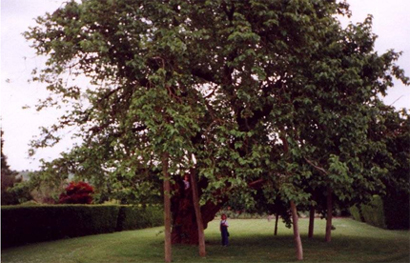
Do you know where you were on Friday, April 27, 2007? Heedlessly, I overlooked National Arbor Day. Once again, I missed out on the popular activities associated with this unheralded holiday; planting, chanting, hugging. I would have forgotten it completely if it had not been for the Internet.
While searching for information on white mulberry trees, I noticed a reference to National Arbor Day. I hadn’t thought of Arbor Day in years. I would wager that Arbor Day greeting cards were left unsold and that few raucous festivals were heralding the arrival of Arbor Day.
It is an overlooked holiday and a forgotten idea. Maybe this is because National Arbor Day originated in Nebraska. On January 4, 1872, National Arbor Day was proposed by J. Sterling Morton as a tree planting holiday. At that time, Nebraska was basically a treeless territory. As a newspaper editor, Morton encouraged his readers to plant trees for windbreaks and to avoid soil erosion. Trees were needed to warm their hearths, and to build a state.
There are misconceptions concerning Arbor Day. One misconception is that Arbor Day is a secret society of Masonic Farmers and Geometry teachers. Another common misconception is that Arbor Day is an annual reminder to secure arbors and ports.
There is a dark side to Arbor Day. Like honey bees and breathing, we take trees for granted. Many times, a grove of trees and even a single tree is honored after they have been destroyed. The Arboretum Retail Center on NC Highway 51 is named in respect of the grove of trees that had to be bulldozed before the first foot of cement could be poured. We take trees for granted; sometimes while sitting in the shade.
Trees give us a sense of place. The tree of life is a popular icon, the Carolinas Medical Association symbol is an abstract of a tree. One insurance corporation’s symbol is a reminder of the comfort beneath a shade tree.
A freshly planted tree is belief in the future and proof of the past. Trees are sentinels to history and sometimes, dreams. The white mulberry tree at the corner of Hawthorne and Central in Mt. Holly was planted in a time when a new nation dreamed of developing a silk industry for export to Europe.
According to local lore, the white mulberry tree was planted by French botanist, Andre Michaux during his exploration of the Carolinas. In 1785, by order of the French King, Louis XVI, Michaux was sent to explore the North American continent to investigate trees and plants that would benefit France.
Michaux’s original instructions were locate tree species that would thrive in the French climate. It seems the French had chopped down most of the native trees and forests during a recent war. This little known fact gives new meaning to the French royal title, “Sun King.â€
Michaux explored the Carolinas extensively. In 1786, he built a garden in Charleston, SC, and maintained it for a decade. There is a marker on the right just past Belmont Abbey College and before the bridge over NC Hwy I-85 that commemorates the French Botanist’s time in this area.
Almost a decade before the Lewis and Clark expedition, Thomas Jefferson encouraged Michael Michaux to lead a western exploration across America. But the French Revolution began and Michael Michaux returned to France.
It is believed that during his visit in the area, he was a guest of the Robert Alexander family. In the early years of the 16th century, Alexander was among the first back country settlers to build a home in what is now the City of Mt. Holly. Alexander built his cabin at the highest point of land above the Catawba River and christened his hand-hewn estate, Woodlawn. His sturdy cabin was referred to by his South Fork neighbors as the ‘red house.’ It was built on stone foundations and gun turrets were set into the walls for defense against Indian raids. At times, the basement served as a temporary jail.
Robert Alexander was married to Mary Jack, the sister of Captain Jack who had carried the Mecklenburg Declaration of Independence to Philadelphia on May 20, 1775. Alexander was a veteran Indian fighter, a former Regulator, a former member of the North Carolina legislature, and a steadfast Patriot soldier in the American Revolution. On August 14, 1775, in response to the Battle of Lexington, Alexander signed the Tryon Resolves, a revolutionary list of charges against the British. The Tryon Resolves were signed by forty-nine settlers in what was then Tryon County. Over time, Tryon County was changed to Lincoln County and this area later became part of Gaston County.
The Revolution had been won, thoughts of trade and commerce, occupied men’s minds. A silk industry was one of the earliest hopes of the American colonies. King James instructed the Virginia colonies to establish a silk trade, but the silk project was abandoned following decades of disappointment. In Chatham County, NC, the community of Silk Hope is a reminder of an era when a thriving silk industry was attempted. Per the Internet source, Wikipedia, the production of silk was a successful industry in Connecticut for close to two centuries.
Local historians believe silk was on Robert Alexander’s mind when he met Michael Michaux. It is believed that the white mulberry tree was planted by Michael Michaux on the Alexander property because it is the natural home of the silk worm.
In the past two hundred years this mulberry tree has stood firm against floods, hurricanes and droughts. It is a heroic sentinel to our history.
In my research, I found a notice of the auctioning of naming rights of treasure trees in Shanghai. A treasure tree is an ancient sentinel tree to history. This white mulberry tree is a treasure tree and it needs our help. A tropical storm has bent this monarch of a tree to the ground. Now, it is even attempting to re-root one of its limbs in the ground. Mr. Charles Sawyer owns the land where the tree stands. He has graciously allowed me to write about the tree and its history.
When the 2008 National Arbor Day arrives, I hope the community of Mt. Holly and its businesses will have designated this historic white mulberry tree a treasure tree.
On behalf of Arborists everywhere, I would like to think the communities of Mt. Holly, Gaston County and, even the State of NC, will have made every effort for this magnificent tree to thrive for another two hundred years and our ancestors will continue to care for the white mulberry tree at the corner of Hawthorne and Central.


